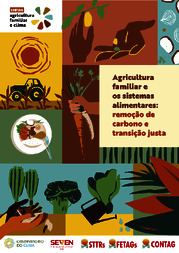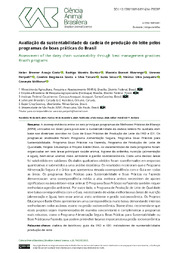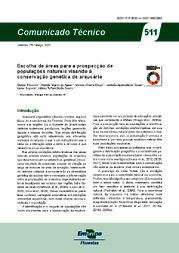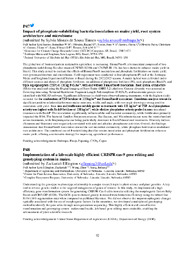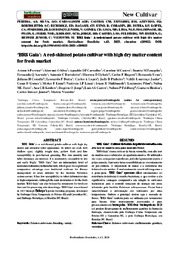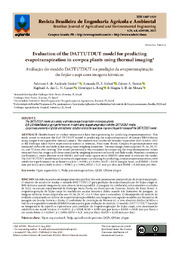Copper phytoextraction and phytostabilization by Brachiaria decumbens Stapf. in vineyard soils and a copper mining waste.
Filter by:
| Author(s): LIMA, C. E. P.; RUBINSTEIN, F. B. P. L.; AMARAL, J. de B.; LEAL, L. S.; ZOCHE, R.; BONETTI, S. P. A livro discute os desafios e oportunidades da agricultura familiar no contexto da crise climática global. A publicação destaca o papel estratégico dos agricultores familiares na mitigação das mudança... ... |
| Author(s): COSTA, H; DANTAS, R. M.; ALVARENGA, M. B.; PERIPOLLI, V.; TANURE, C. B. G. e S.; SEIXAS, L.; JUNQUEIRA, V. S.; MCMANUS, C. A correspondência entre os seis principais programas de Melhores Práticas de Manejo (MPM) utilizados no Brasil para promover a sustentabilidade da cadeia leiteira foi avaliada com base nas diretrizes... ... |
| Author(s): FRITZSONS, E.; AGUIAR, A. V. de; WREGE, M. S.; SOUSA, V. A. de; BOGNOLA, I. A.; SOARES, M. T. S. Araucaria angustifolia (Bertol.) Kuntze, espécie típica do ecossistema da Floresta Ombrófila Mista, ocorre nas regiões Sul e Sudeste do Brasil, sobre distintos substratos geológicos, feições geomorfol... ... |
| Author(s): SANTOS, J. W. M.; OLIVEIRA, R. G.; AVELAR, J. S.; SANTOS, F. C. dos; OLIVEIRA-PAIVA, C. A.; GOMES, E. A.; LANA, U. G. de P.; SOUSA, S. M. de This study aimed to evaluate the effects of BiomaPhos® inoculation and phosphate fertilization on maize yield, root system architecture and microbiome. Field experiment was conducted in low-phosphorus... ... |
| Author(s): NEGRI, B. F.; MACIEL, L. S.; COELHO, A. M.; BARROS, B. de A.; GUIMARÃES, C. T.; MAGALHAES, J. V. de; SOUSA, S. M. de In maize and sorghum, candidate genes were co-localized with quantitative trait loci (QTL) associated with root morphology, dry weight, and grain yield under low P. To validate the function of these g... ... |
| Author(s): SANTOS, V. S. DO A.; SOUSA, P. H. M. DE; NUNES, G. M. V. C.; BENEVIDES, S. D. A crescente preocupação com o impacto ambiental e a busca por alternativas alimentares sustentáveis têm impulsionado o desenvolvimento de produtos plant-based. Este estudo objetivou elaborar hambúrgue... ... |
| Author(s): SANTOS, L. R. C.; FREITAS, A. D. S.; SILVA, A. F.; MENEZES, R. S. C.; FERNANDES JUNIOR, P. I.; CAMARGO, P. B.; SAMPAIO, E. V. S. B. Soil carbon (C) dynamics are increasingly studied because of their role in theglobal C cycle and potential influence on atmospheric carbon dioxide con-centrations and climatic changes. The substitutio... ... |
| Author(s): PEREIRA, A. da S.; SILVA, G. O. da; CARVALHO, A. D. F. de; CASTRO, C. M.; EMYGDIO, B. M.; AZEVEDO, F. Q.; BORTOLETTO, A. C.; EICHOLZ, E. D.; RAGASSI, C. F.; UENO, B.; CORADIN, J. H.; DUTRA, L. F.; LOPES, C. A.; PINHEIRO, J. B.; LOURENÇO JUNIOR, V.; GOMES, C. B.; LIMA, M. F.; PINHEIRO, N. L.; MALDONADE, I. R.; PILON, L.; PILON, L.; FERRI, N. M. L.; KROLOW, A. C. R.; JORGE, R. O.; CASTRO, L. A. S. de; FELDBERG, N. P.; HEIDEN, G.; REISSER JUNIOR, C.; VIZZOTTO, M. ‘BRS Gaia’ is a red-skinned potato cultivar with high dry matter and attractive tuber appearance. Its tubers are oval, with shallow eyes, slightly rough skin, yellow flesh and low susceptibility to po... ... |
| Author(s): ANDRADE JUNIOR, A. S. de; SOBRAL, A. H. S.; BASTOS, E. A.; CASARI, R. A. das C. N.; ROIG, H. L.; MOURA, M. S. B. de Models based on surface temperature have been promising for predicting evapotranspiration. This study aimed to evaluate the DATTUTDUT model in predicting the evapotranspiration of cowpea BRS-Inhuma us... ... |
| Author(s): MODESTO JUNIOR, M. de S.; ALVES, R. N. B. Este livro contém os resultados de um projeto de transferência de tecnologias sustentáveis, conduzido em Marabá nos anos de 2020 e 2021, para cultivo intensivo de mandioca, visando ao aumento da produ... ... |
Observation
Some of Embrapa's publications are published as ePub files. To read them, use or download one of the following free software options to your computer or mobile device. Android: Google Play Books; IOS: iBooks; Windows and Linux: Calibre.
Access other publications
Access the Agricultural Research Database (BDPA) to consult Embrapa's full library collection and records.
Visit Embrapa Bookstore to purchase books and other publications sold by Embrapa.

